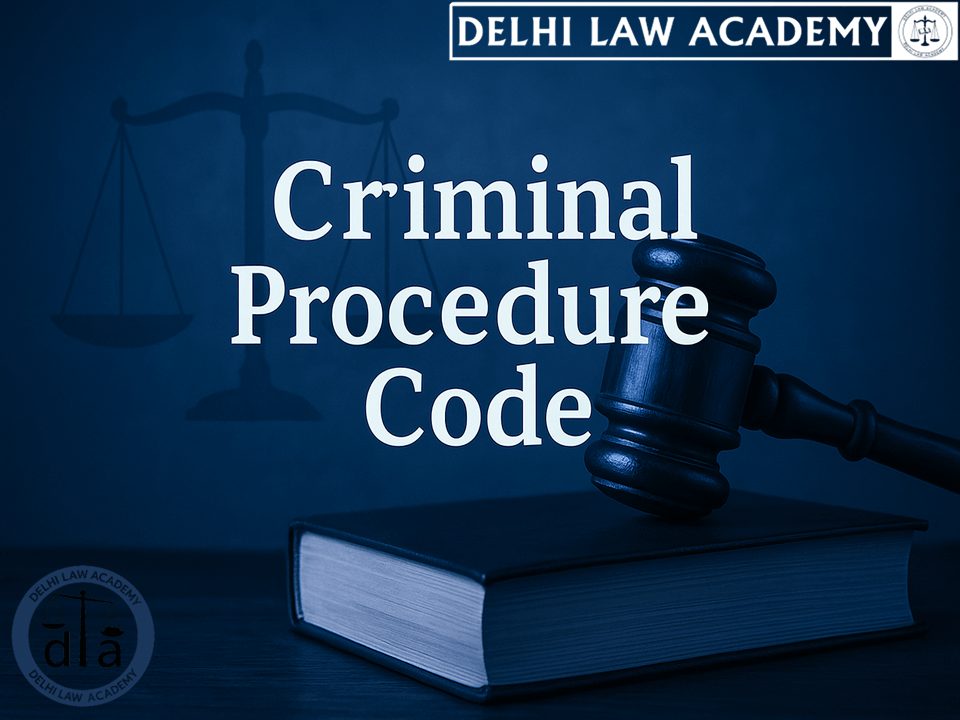
⚖️ CRIMINAL PROCEDURE CODE: BAIL IN BAILABLE OFFENCES
TOPICS
- What is a bail?
- Statutory provisions of bail
- Bail in bailable offences: Section 436 CrPC
- Who is an indigent person?
- Exception to section 436(1)
- A bond without sureties instead of bail
An order of bail gives back to the accused freedom on condition that he will appear to take his trial.
📘 Preparation for RJS, DJS, PCS (J) and other Judicial Service exams
The Criminal Procedure Code forms the bedrock of any and every Judicial Service exam in the country. Its thorough knowledge is a must for all aspirants of RJS, DJS, PCS (J) and every other Judicial Service exam. To help such aspirants, DELHI LAW ACADEMY JAIPUR has launched a series of study material modules on all important aspects of this vital part of their syllabus:
⚖️ PROVISIONS OF BAIL AND BONDS
🔹 What is a bail?
- Any order of bail can be effective only from the time of arrest because, to grant bail, as stated in Wharton’s Law Lexicon, is to ‘set at liberty a person arrested or imprisoned, on security being taken for his appearance’.
- Thus, bail is basically release from restraint.
- An order of bail gives back to the accused freedom on condition that he will appear to take his trial.
- Personal recognisance and suretyship bonds are the means by which an assurance is secured from the accused that though he has been released on bail, he will present himself at the trial of the offence of which he is charged and for which he was arrested.
📜 Statutory provisions:
Section 436 — Bail in bailable offences
- When a person not accused of a non-bailable offence:
- is arrested or detained without warrant by an officer in-charge of a police station or
- appears or is brought before a Court, and is prepared to give bail
- such person shall be released on bail.
🤝 Instead of bail
- Instead of taking bail from such person, such officer or Court may discharge him on his executing a bond without sureties.
💰 Special provision for indigent persons
- If such person is indigent and unable to furnish surety, such officer or Court shall discharge him on his executing a bond without sureties.
👨⚖️ Who is an indigent person?
- Where a person is unable to give bail within a week of his arrest, it shall be sufficient ground to presume that he is an indigent person.
⚠️ Section 436(2): Exception to section 436(1)
- Where a person fails to comply with conditions of bail bond as regards time and place of attendance, Court may refuse to release him on bail when on a subsequent occasion in the same case he appears before Court or is brought in custody.
⏳ Section 436A
- Where a person has undergone detention during investigation or trial up to half of the maximum imprisonment specified for his offence, he shall be released by court on his personal bond, with or without sureties.
- Court may order continued detention longer than half of the maximum imprisonment for reasons to be recorded in writing, or may release him on bail instead of personal bond, with or without sureties.
- No such person shall in any case be detained during investigation or trial for more than the maximum imprisonment for his offence.
🔎 What is bail?
- Traditionally, bail is some form of property deposited or pledged to a court to persuade it to release a suspect from jail on the understanding that he will return for trial or forfeit the bail.
📜 Recognizance
- When an accused is released on recognizance, he promises to court to attend all required judicial proceedings and not to engage in prohibited conduct.
- Typically a monetary amount is set by court but is not paid by the defendant unless court orders it forfeited.
- This is called an unsecured appearance bond or release on one’s own recognizance.
💼 Surety Bond
- By a surety bond, a third party agrees to be responsible for debt or obligation of the defendant.
🏠 Property Bond
- Accused or a person acting on his behalf pledges real property having a value at least equal to amount of bail.
- If the principal fails to appear for trial, State can institute foreclosure proceedings against the property to recover the bail.
💵 Cash
- Court-ordered cash bonds require total amount of bail to be posted in cash.
- Court holds this money until the case is concluded.
❓ Frequently Asked Questions on Bail in Bailable Offences (CrPC Section 436)
In non-bailable offences, bail is not a right — it’s subject to the court’s discretion based on the seriousness of the crime and the risk of flight or tampering with evidence.
This provision, inserted in 2006, ensures that poverty doesn’t deny anyone the right to liberty.
However, under Section 436(2) CrPC, if the accused violates bail conditions or fails to appear in court after release, the court may refuse bail in subsequent appearances.
This prevents excessive detention without trial.
- 🔹 Personal Recognizance Bond: Accused promises to appear without financial deposit.
- 🔹 Surety Bond: Third party guarantees the accused’s presence.
- 🔹 Property Bond: Real property pledged as security for bail.
- 🔹 Cash Bond: Entire bail amount deposited in court.
📘 Free Study Material for Judiciary Aspirants!
Download our FREE study material prepared by Delhi Law Academy’s expert faculty.
Contact us
📍 Delhi Law Academy – Jaipur Branch
6C, Tower 2, Coaching Hub, Pratap Nagar, Jaipur – 302033
📞 Phone:
+91 9911916552
+91 8447285606
✉️ Email:
contactus@delhilawacademy.com

